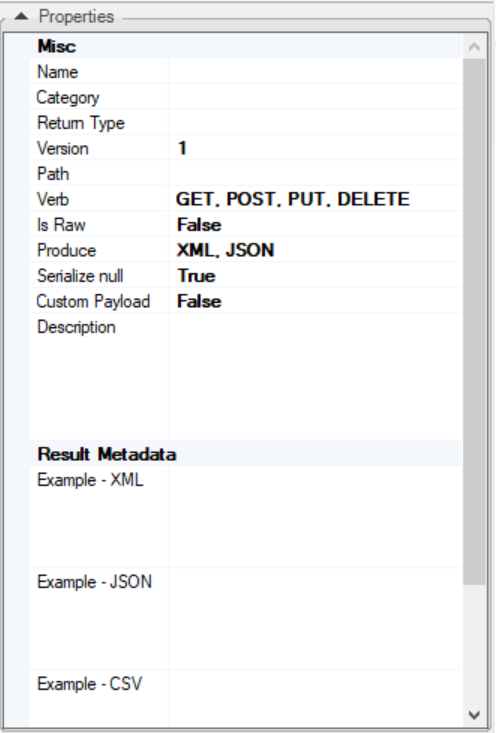Web Service Properties
Fabric Web Services properties include the definitions, methods, categories and essential metadata that contribute to the main functionalities and characteristics of the Web Service.
Web Service Properties are located on the top right corner of the Web Service window.

The following are the Web Services properties:
How Do I Generate HTML Format or Legacy JSON/XML ?
To generate these formats, open the Java Logic file and add the following tag above the public class which encapsulates the Web Services defined in the specific Logic category:
```java @legacy public class Logic extends WebServiceUserCode {…}
Then add the UNKNOWN value to the Produce function call in the line where the Web Service is defined:
java @webService(path = "test/getCustomerInfo", verb = {MethodType.GET, MethodType.POST, MethodType.PUT, MethodType.DELETE}, version = "1", isRaw = false, produce = {Produce.UNKNOWN})
Modify the Properties panel of the Web Service with Produce = "UNKNOWN" and Return Type = "Object".
After deploying the Web Service, call it from the browser using the appropriate token, parameter and format.
Example with HTML format:
html
http://localhost:3213/api/test/getCustomerInfo?ID=1000&token=tgreg&format=html
```
The response is displayed in the body of the browser's web page:
Web Service Properties
Fabric Web Services properties include the definitions, methods, categories and essential metadata that contribute to the main functionalities and characteristics of the Web Service.
Web Service Properties are located on the top right corner of the Web Service window.

The following are the Web Services properties:
How Do I Generate HTML Format or Legacy JSON/XML ?
To generate these formats, open the Java Logic file and add the following tag above the public class which encapsulates the Web Services defined in the specific Logic category:
```java @legacy public class Logic extends WebServiceUserCode {…}
Then add the UNKNOWN value to the Produce function call in the line where the Web Service is defined:
java @webService(path = "test/getCustomerInfo", verb = {MethodType.GET, MethodType.POST, MethodType.PUT, MethodType.DELETE}, version = "1", isRaw = false, produce = {Produce.UNKNOWN})
Modify the Properties panel of the Web Service with Produce = "UNKNOWN" and Return Type = "Object".
After deploying the Web Service, call it from the browser using the appropriate token, parameter and format.
Example with HTML format:
html
http://localhost:3213/api/test/getCustomerInfo?ID=1000&token=tgreg&format=html
```
The response is displayed in the body of the browser's web page:





